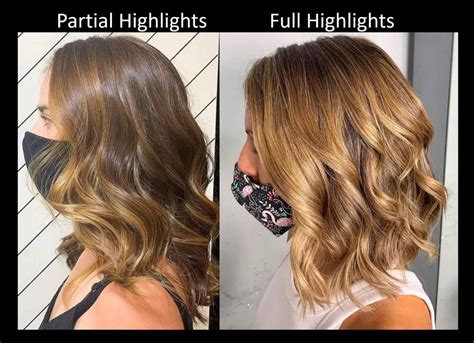Introduction
When it comes to injecting life and dimension into your hair, highlights are an eternal favorite. But navigating the realm of partial vs. full highlights can be a daunting task. This comprehensive guide will delve into the intricacies of these techniques, empowering you with the knowledge to achieve your desired hair transformation.

Partial Highlights: A Subtle Transformation
Partial highlights target specific strands or sections of hair, resulting in a more natural and less noticeable effect. These strategically placed highlights add depth, warmth, and subtle dimension to your mane without overwhelming its overall color.
Benefits of Partial Highlights:
- Natural-looking: Partial highlights mimic the sun-kissed effect, creating a gradual transition between colors.
- Versatile: Suitable for all hair types and colors, partial highlights can enhance and flatter any base shade.
- Low-maintenance: Requires fewer touch-ups, making them a time-saving option.
- Cost-effective: Typically more affordable than full highlights.
Full Highlights: A Bold Statement
Full highlights involve highlighting the entire head of hair, resulting in a bolder and more dramatic transformation. This technique creates an even distribution of color throughout your locks, adding vibrancy, contrast, and a youthful glow.
Benefits of Full Highlights:
- High impact: Full highlights make a noticeable difference in your overall appearance, adding personality and style.
- Versatile: Can be customized to complement different skin tones and hair colors.
- Trendy: Remains a timeless and popular choice, keeping you on-trend.
- Covers grays effectively: Hides unwanted grays and enhances hair’s overall luster.
Common Mistakes to Avoid
- Over-highlighting: Excessive highlighting can damage hair and create an unnatural, brassy effect.
- Incorrect placement: Poorly placed highlights can accentuate unwanted facial features or overwhelm your natural hair color.
- Improper application: Using outdated techniques or incorrect products can lead to uneven or blotchy results.
- Over-processing: Excessive processing time can weaken hair follicles and cause breakage.
Pros and Cons: A Comparison
| Feature | Partial Highlights | Full Highlights |
|---|---|---|
| Subtlety | Higher | Lower |
| Coverage | Specific sections | Entire head |
| Maintenance | Lower | Higher |
| Cost | Lower | Higher |
| Versatility | High | High |
| Trendiness | More subtle | More noticeable |
6-8 FAQs
- Which technique is better for covering grays? Full highlights provide better coverage for grays.
- How often should I get highlights? The frequency depends on your desired level of contrast and hair growth rate; typically, every 6-8 weeks for partial highlights and 8-12 weeks for full highlights.
- Can I highlight my hair at home? It’s not recommended to do so unless you have professional experience.
- What is the difference between foils and balayage? Foils create precise, defined highlights, while balayage involves hand-painting for a more blended effect.
- Can highlights damage my hair? Yes, if not done correctly. Professional stylists using high-quality products minimize the risk.
- How can I maintain the vibrancy of my highlights? Use sulfate-free shampoos, deep conditioners, and UV protectant products.
Applications of Partial vs. Full Highlights
- Partial: Subtle hair enhancements, framing the face, creating dimension around layers, adding warmth or coolness to specific areas.
- Full: Bold hair transformations, correcting uneven color, covering grays, creating contrasting or complementary shades, elevating the overall appearance.
Creative New Word: “Dimensionality”
Dimensionality refers to the multidimensional effect created by highlights, adding depth, interest, and movement to hair. This new word encapsulates the transformative power of highlights, enhancing the overall beauty and vibrancy of your locks.
Tables: Useful Information at a Glance
Table 1: Highlight Techniques Comparison
| Technique | Coverage | Effect |
|---|---|---|
| Partial Highlights | Specific sections | Subtle, natural-looking |
| Full Highlights | Entire head | Bold, dramatic |
Table 2: Cost and Maintenance
| Type | Cost | Maintenance |
|---|---|---|
| Partial Highlights | Lower | Lower |
| Full Highlights | Higher | Higher |
Table 3: Suitable Hair Types and Colors
| Hair Type | Suitable for |
|---|---|
| Fine hair | Partial highlights |
| Coarse hair | Partial or full highlights |
| Dark hair | Partial highlights |
| Light hair | Partial or full highlights |
Table 4: Common Mistakes to Avoid
| Mistake | Consequence |
|---|---|
| Over-highlighting | Hair damage, brassiness |
| Incorrect placement | Unflattering effects |
| Improper application | Uneven, blotchy results |
| Over-processing | Hair weakness, breakage |
Conclusion
Partial and full highlights offer distinct approaches to hair transformation, catering to different needs and preferences. Partial highlights provide subtle dimension and natural enhancements, while full highlights create a bold and dramatic statement. Understanding the nuances of each technique and avoiding common mistakes will empower you to achieve your dream hair. Whether you desire a touch of sun-kissed glow or a vibrant color transformation, the right type of highlights will illuminate your locks and elevate your overall style.
